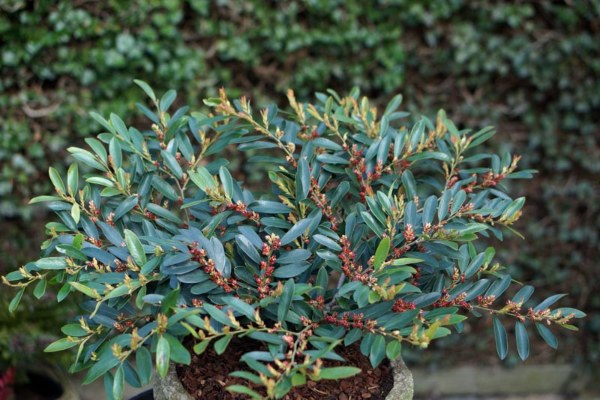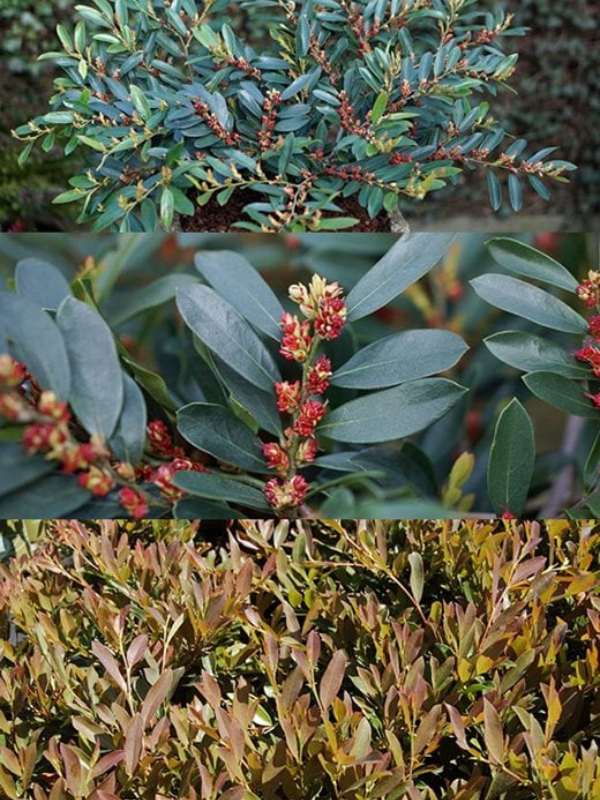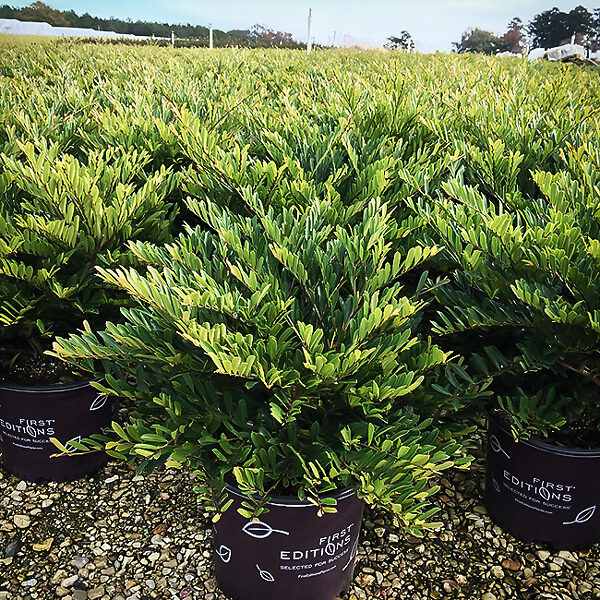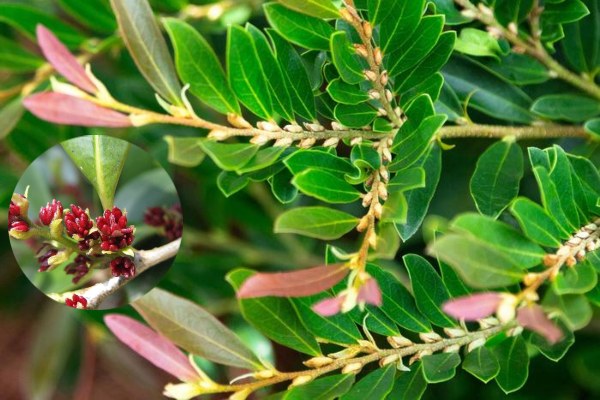Distylium is a relatively well-known and growingly popular evergreen shrub that is both sturdy and beautiful. Other than being low-maintenance, these hardy shrubs will add aesthetic value throughout the year.
In this article, we will explore everything you need to know about Distyliums including the care tips, variations, and methods for growing and maintaining these amazing evergreen shrubs.
Overview
Plant Type: Perennial
Season: Fall or Early Spring
Family: Hamamelidaceae
Native Area: Eastern and Southeastern Asia
Maturity Date: +2 years
Introduction to Distylium Plants
Distylium Plants belong to the Hamamelidaceae family, originally from eastern and southeastern Asia. This evergreen shrub features shiny, leathery leaves with small, inconspicuous flowers normally reddish-marron in color.
In the same way, these flowers add color to the landscape that blooms from late January to March. It is very adaptable and can be grown in a wide range of conditions, which makes the plant strong and low maintenance in the garden.

Understanding Distylium Varieties
Distylium is a fascinating genus with almost 18 distinct species. These plants range from low, spreading mounds to tall, upright forms. Distylium is a great alternative to boxwood, laurels, hollies, junipers, and other common home garden landscaping choices.
They require low maintenance and retain their evergreen leaves year-round, making them a great choice for any yard adding varied textures and appealing. Some notable varieties are,
Cinnamon Girl Distylium
Cinnamon Girl Distylium is a versatile, beautiful evergreen shrub best known for its plum-purple new growth, turning blue-green as the leaves mature. It grows 1 to 3 feet tall and wide. Similarly, it thrives in full sun to partial shade.
It also produced small, inconspicuous flowers that bloom in the winter and add a touch of delicacy to any garden. Cinnamon Girl Distylium is further popular for its year-round blooming, low maintenance, and drought tolerance, perfect for borders, hedges, or large groupings in gardens.
Vintage Jade Distylium
Vintage Jade Distylium is another evergreen shrub, with layered branches forming a spreading mound, ideal for foundations or large areas. It typically matures at a height of 2 to 3 feet and a width of 4 to 5 feet.
The foliage of this plant is deep, green, resistant to disease, and stays year-round. Likewise, it also puts out little red flowers in winter for a breathtaking pop of color in any garden. Vintage is a hardy, low-maintenance plant that thrives in various soils and sun exposures.
Linebacker Distylium
Linebacker Distylium, Distylium x ‘PIIDIST-I’, is a very tough plant that grows upright. When young, it resembles a round barrel, but as it matures, it is useful in forming screens or hedges. Linebacker foliage is notable for its outstanding color transformation, with young foliage being bright red, changing to glossy green as it matures. Further, this plant tolerates a wide range of soil types and living conditions, as it grows easily in both full sun and moderate shade.
Coppertone Distylium
Coppertone Distylium is known for its bright coppery-red new foliage, which matures to a cool blue-green. It is one of the most popular Distylium shrubs because of its adaptability and disease tolerance, making it the perfect choice for many plant enthusiasts and garden settings. Moreover, this low-maintenance evergreen thrives in full sun to partial shade and will grow in a variety of soils.

Swing Low Distylium
Swing Low Distylium is an evergreen shrub with blue-green leaves that grow densely on horizontal branches. This plant lasts year-round and also produces small red flowers in late winter. It grows to 2-3 feet tall and spreads to 4-6 feet wide. This versatile plant is adaptable to various landscapes and does great in many different soils and sun exposures. Likewise, its low maintenance makes it a popular choice for any garden.
Bayou Bliss Distylium
Bayou Bliss Distylium, also formerly known as Jewel Box Distylium, features soft, blue-green foliage in a compact, rounded form. It matures to 3-4 feet in height and 4-6 feet in width. This is a low-maintenance shrub that grows in a variety of soils, handles full sun to partial shade, and is pest- and disease-resistant.
Emerald Heights Distylium
Emerald Heights Distylium features dark green, shiny foliage. It also produced dark red flowers, adding a special touch of color. It grows 5 to 6 feet tall and wide, which is perfect for creating lush hedges, defining borders, and enhancing mass plantings with its dense, vibrant foliage.
Jewel Box Distylium
Jewel Box, also referred to as Evergreen Witchhazel, is a compact Distylium in a rounded form with fine texture. Its graceful, arching stems drape with soft, blue-green leaves, making it a versatile choice for mass plantings, borders, or hedges. Jewel Box also produced small red flowers in late winter.
Growing Distylium: Essential Care and Growth Tips
Proper care and cultivation can help to grow healthy Distylium. Fortunately, Distylium is quite easy to grow and can add beauty to any garden. Here, we explore the primary care steps to grow Distylium while ensuring healthy and abundant blooms.
Light
Distylium thrives in full sun to partial shade. Make sure to provide distylium with a minimum of 4 to 6 hours of direct sunlight each day for optimal growth and foliage development.
Soil and Water
This evergreen shrub grows well in a wide range of soils but does best in moist, well-drained soils. Water thoroughly twice a week after planting. To have the best results with Distylium, plant it in well-draining soil with a slightly acidic to neutral pH. Add organic matter to clay or sandy soils to improve drainage and fertility. It is drought-tolerant when established, but will need consistent moisture during the first growing season to develop a good root system. Water deeply but do not overwhelm.

Fertilizer
Feed these plants in spring with a balanced, slow-release fertilizer. Apply it in early spring, before new growth appears, and again according to the label instructions for application rates and frequency.
Pruning
These evergreen shrubs do not require pruning. If needed, prune in early spring right after flowering. Remove dead, damaged, or diseased branches as needed. Light pruning in late winter or early spring helps maintain shape and encourages dense growth.
Pests and Disease
Being hardy, Distylium is usually highly resistant to pests and diseases. However, it is still important to monitor for common problems like aphids, scale insects, or fungal diseases, and treat them promptly if detected.
Also read, Blue Flax Care Guide: Planting, Growing, and Maintenance
Frequently Asked Questions
1. Is Distylium evergreen?
Yes, Distylium is a relatively well-known and growingly popular evergreen shrub that is both sturdy and beautiful.
2. Does vintage Jade Distylium bloom?
Yes, Vintage Jade Distylium blooms in winter. It produces little red flowers that add a breathtaking pop of color to any garden.
3. How tall does Vintage Jade grow?
Vintage Jade typically matures at a height of 2 to 3 feet and a width of 4 to 5 feet.
4. What is the best time to plant Distylium?
The best time to plant Distylium is in the early spring or fall.
5. How often should I water my Distylium?
Water distylium thoroughly twice a week after planting. It is drought-tolerant when established, but will need consistent moisture during the first growing season to develop a good root system. Water deeply but do not overwhelm.
